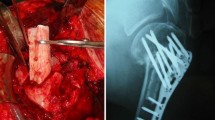Abstract
The aim of this study is to test the efficacy of a novel tissue-engineered bone in repairing bone defects, using poly-lactic-acid–polycaprolactone (PLA–PCL) scaffolding seeded with PEG-bone morphogenetic protein-2 (BMP-2)-transfected rBMSCs (rabbit bone marrow stromal cells). The rBMSCs were transfected with PEG/BMP-2 or liposome/BMP-2, and then implanted into a PLA–PCL tissue-engineered bone. The protein level of BMP-2 was assessed by Western blot analysis and immunohistochemistry. ELISA was used to measure the amount of BMP-2 secreted in the culture media. The mRNA level of BMP-2 and osteocalcin was assayed quantitatively by real-time PCR. The middle portion of the bilateral radius in New Zealand rabbits was excised and implanted with tissue-engineered bone, and the modified areas were monitored by X-ray, hematoxylin–eosin staining, and immunohistochemistry staining of BMP-2. PEG–BMP-2 nanoparticles (NPs) and BMP-2-loaded PEG–PLA–PCL tissue-engineered bones were successfully constructed. The novel PEG–PLA–PCL NPs/DNA complex was a superior option for transfecting BMP-2 in rBMSCs compared to normal liposomes Moreover, the mRNA level of osteocalcin and alkaline phosphatase activity was also elevated upon transfection of BMP-2-encapsulated NPs. In vivo implants with BMP-2-carried tissue-engineered bone exhibited dramatic augmentation of BMP-2 and effective bone formation in the rabbit ectopic model. The PEG–PLA–PCL NPs/BMP-2 complex had an advantageous effect on bone repair, which provided an important theoretic basis for potential clinical treatments.




















Similar content being viewed by others
References
Han, D., & Li, J. (2013). Repair of bone defect by using vascular bundle implantation combined with Runx II gene-transfected adipose-derived stem cells and a biodegradable matrix. Cell and Tissue Research, 352, 561–571.
He, X., Dziak, R., Yuan, X., Mao, K., Genco, R., et al. (2013). BMP2 genetically engineered MSCs and EPCs promote vascularized bone regeneration in rat critical-sized calvarial bone defects. PLoS ONE, 8, 60473.
Li, J., Zhao, Q., Wang, E., Zhang, C., Wang, G., et al. (2012). Transplantation of Cbfa1-overexpressing adipose stem cells together with vascularized periosteal flaps repair segmental bone defects. The Journal of surgical research, 176, 13–20.
Van Hout, W. M., Mink van der Molen, A. B., Breugem, C. C., Koole, R., & Van Cann, E. M. (2011). Reconstruction of the alveolar cleft: can growth factor-aided tissue engineering replace autologous bone grafting? A literature review and systematic review of results obtained with bone morphogenetic protein-2. Clinical Oral Investigations, 15, 297–303.
Zhao, Y. P., Tian, Q. Y., Frenkel, S., & Liu, C. J. (2013). The promotion of bone healing by progranulin, a downstream molecule of BMP-2, through interacting with TNF/TNFR signaling. Biomaterials, 34, 6412–6421.
Biver, G., Wang, N., Gartland, A., Orriss, I., Arnett, T. R., et al. (2013). Role of the P2Y receptor in the differentiation of bone marrow stromal cells into osteoblasts and adipocytes. Stem Cells, 31(27), 2747–2758.
Gharibi, B., Abraham, A. A., Ham, J., & Evans, B. A. (2011). Adenosine receptor subtype expression and activation influence the differentiation of mesenchymal stem cells to osteoblasts and adipocytes. Journal of Bone and Mineral Research, 26, 2112–2124.
Backly, R. M., & Cancedda, R. (2010). Bone marrow stem cells in clinical application: Harnessing paracrine roles and niche mechanisms. Advances in Biochemical Engineering/Biotechnology, 123, 265–292.
Liu, H., Peng, H., Wu, Y., Zhang, C., Cai, Y., et al. (2013). The promotion of bone regeneration by nanofibrous hydroxyapatite/chitosan scaffolds by effects on integrin-BMP/Smad signaling pathway in BMSCs. Biomaterials, 34, 4404–4417.
Zou, D., Zhang, Z., He, J., Zhu, S., Wang, S., et al. (2011). Repairing critical-sized calvarial defects with BMSCs modified by a constitutively active form of hypoxia-inducible factor-1alpha and a phosphate cement scaffold. Biomaterials, 32, 9707–9718.
Zou, D., Zhang, Z., Ye, D., Tang, A., Deng, L., et al. (2011). Repair of critical-sized rat calvarial defects using genetically engineered bone marrow-derived mesenchymal stem cells overexpressing hypoxia-inducible factor-1alpha. Stem Cells, 29, 1380–1390.
Mahon, E., Salvati, A., Baldelli Bombelli, F., Lynch, I., & Dawson, K. A. (2012). Designing the nanoparticle-biomolecule interface for “targeting and therapeutic delivery”. Journal of Controlled Release, 161, 164–174.
Pearce, T. R., Shroff, K., & Kokkoli, E. (2012). Peptide targeted lipid nanoparticles for anticancer drug delivery. Advanced Materials, 24(3803–3822), 710.
Ruoslahti, E. (2012). Peptides as targeting elements and tissue penetration devices for nanoparticles. Advanced Materials, 24, 3747–3756.
Huang, Y. C., Connell, M., Park, Y., Mooney, D. J., & Rice, K. G. (2003). Fabrication and in vitro testing of polymeric delivery system for condensed DNA. Journal of Biomedical Materials Research Part A, 67, 1384–1392.
Luu, Y. K., Kim, K., Hsiao, B. S., Chu, B., & Hadjiargyrou, M. (2003). Development of a nanostructured DNA delivery scaffold via electrospinning of PLGA and PLA–PEG block copolymers. Journal of Controlled Release, 89, 341–353.
Mussano, F., Ciccone, G., Ceccarelli, M., Baldi, I., & Bassi, F. (2007). Bone morphogenetic proteins and bone defects: A systematic review. Spine, 32, 824–830.
Lissenberg-Thunnissen, S. N., de Gorter, D. J., Sier, C. F., & Schipper, I. B. (2011). Use and efficacy of bone morphogenetic proteins in fracture healing. International Orthopaedics, 35, 1271–1280.
Li, X., Huang, Y., Zheng, L., Liu, H., Niu, X., et al. (2013). Effect of substrate stiffness on the functions of rat bone marrow and adipose tissue derived mesenchymal stem cells in vitro. Journal of Biomedical Materials Research Part A, 102(4), 1092–1101.
Wang, Y., Li, J., Wang, Y., Lei, L., Jiang, C., et al. (2012). Effects of hypoxia on osteogenic differentiation of rat bone marrow mesenchymal stem cells. Molecular and Cellular Biochemistry, 362, 25–33.
Acknowledgments
This study was supported by Science and Technology Research Project of Liaoning Provincial Department of Education, No. 2010652.
Conflict of interest
The authors have not declared any conflicts of interest.
Author information
Authors and Affiliations
Corresponding author
Rights and permissions
About this article
Cite this article
Xu, X., Yang, J., Ding, L. et al. Bone Morphogenetic Protein-2-Encapsulated Grafted-Poly-Lactic Acid–Polycaprolactone Nanoparticles Promote Bone Repair. Cell Biochem Biophys 71, 215–225 (2015). https://doi.org/10.1007/s12013-014-0187-y
Published:
Issue Date:
DOI: https://doi.org/10.1007/s12013-014-0187-y




